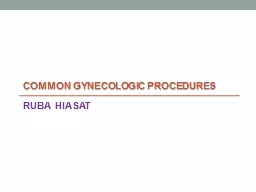

RUBA HIASAT Hysteroscopy Hysteroscopy involves passing a smalldiameter telescope either flexible or rigid through the cervix to directly inspect the uterine cavity A flexible hysteroscope may be used in the outpatient ID: 907846
Download The PPT/PDF document "Common gynecologic procedures" is the property of its rightful owner. Permission is granted to download and print the materials on this web site for personal, non-commercial use only, and to display it on your personal computer provided you do not modify the materials and that you retain all copyright notices contained in the materials. By downloading content from our website, you accept the terms of this agreement.
Slide1
Common gynecologic procedures
RUBA HIASAT
Slide2Hysteroscopy
Hysteroscopy involves passing a small-diameter telescope, either flexible or rigid, through the cervix to directly inspect the uterine
cavity….
.
A flexible hysteroscope may be used in the outpatient
setting…
Rigid instruments employ circulating fluids and therefore can be used to visualize the uterine cavity even if the woman is bleeding.
Slide3Rigid telescopes are most commonly 1 to 5 mm in diameter for diagnostic procedures,
and operative hysteroscopes typically range from 8 to 10 mm in
diameter
may be
more effective than diagnostic D&C in detecting intrauterine pathology such as
endometrial polyps ,fibroid
or submucous
myomata.
Can be used for directed endometrial biopsy
Under local-intravenous or general anesthesia
Slide4Slide5Indications
Any abnormal bleeding from the uterus can be investigated by hysteroscopy, including:
•
1-
Postmenopausal bleeding
.
•
2-Irregular
menstruation,
intermenstrual
bleeding and
postcoital
bleeding.
•3-
Persistent heavy menstrual bleeding.
•4-
Persistent discharge.
•
5-Suspected
uterine
malformations
Slide66- Endometrial
Ablation
Endometrial ablation is the destruction of the uterine lining for the treatment of chronic menorrhagia.
It is performed when more conservative treatments, such as hormone therapy and curettage, are unsuccessful and when the more radical alternative of hysterectomy is undesirable or contraindicated.
The first type requires hysteroscopic visualization
Slide7• If there is infection present, hysteroscopy can cause ascending infection.
Slide8Laparoscopy
Laparoscopy allows visualization of the peritoneal cavity. This involves insertion of a needle called a
Veress
needle into a suitable puncture point in the
umbilicus …
together
with
insufflation with either CO2 or nitrous
oxide to distend the abdomen and left the abdomen away from the viscera
. Under general anesthesia
.
The majority of instruments used for diagnostic laparoscopy are 5 mm in diameter, and 10
mm for therapeutic
Slide9The procedure is performed with the patient in a modified dorsal lithotomy position
Upon
completion of the procedure, hemostasis is checked, the gas is released from the peritoneal cavity and the instruments are withdrawn. The small skin incisions are closed with a clip or single
subcuticular
suture
Slide10Indications
• Suspected ectopic pregnancy.
• Ovarian cyst accident and acute pelvic pain.
• Undiagnosed pelvic pain.
• Tubal patency testing.
•
Sterilization.
Slide11Endometriosis
(
for the diagnosis, staging, and treatment of ectopic endometrial tissue in both overtly symptomatic (pelvic pain) and silently symptomatic (infertility) patients
.)
more extensive laparoscopic work is now performed for hysterectomy, lymph node biopsy,
omentectomy
and myomectomy.
Slide12Slide13Complications
Complications are uncommon, but include damage to any of the intra-abdominal structures, such as bowel and major blood vessels. The bladder is always emptied prior to the procedure to avoid bladder injury. Incisional hernia has been reported.
Slide14Absolute contraindications
Bowel obstruction
Large hemoperitoneum with hypovolemic shock
Slide15Open laparoscopy?
In patients who have had:
Multiple previous laparotomies
A history of peritonitis
Previous bowel surgery
Lower midline abdominal incision
Open laparoscopy is preferable. In these conditions, the
peritoneal cavity is opened through a small
subumbilical
incision under direct visualization
Slide16Cystoscopy
Cystoscopy involves passing a small-diameter telescope, either flexible or rigid, through the
urethra into the bladder
. Excellent images of both these structures can be obtained. A
cystoscope
with an operative channel can be used to biopsy any abnormality, perform bladder neck injection, retrieve stones and resect bladder
tumours
.
Slide17Indications
• Haematuria.
• Recurrent urinary tract infection.
• Sterile pyuria.
• Short history of irritative symptoms.
• Suspected bladder abnormality (e.g. diverticulum, stones, fistula).
• Assessment of bladder neck.
Complications
• Urinary tract infection.
• Rarely, bladder
perforation
Slide18
Slide19MYOMECTOMY
The surgical technique for resection of
uterine
leiomyomas
(fibroids).
3 Different routes;
abdominal
,
vaginal
and
laproscopic
.
Consideration before the procedure:
1- Symptoms
2- Menopausal state
3- Fertility desire
4- Size
5- Site
Slide20Indications
:
Abdominal pain/pressure symptoms
Suspicion of malignancy
Infertility and/or recurrent pregnancy loss
Abnormal
bleeding
Slide21Hysterosalpingogram
(HSG)
IS A DIAGNOSTIC OUTPATIENT radiologic imaging procedure performed without anesthesia ..
A cannula is placed in the
endocervical
canal and radio opaque fluid is injected ..allowing assessment of uterine malformation (uterine septum ) and a Sherman's syndrome
Slide22Tubal pathology can also be assessed by observing internal tubal anatomy and seeing whether the dye spills in to pelvis cavity
Slide23Thank you